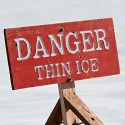LAKE GEORGE, N.Y. – The Adirondack Mountain Club (ADK) may soon have a new chapter devoted to enhancing and promoting the celebrated Northville-Placid Trail (NPT).
The NPT, which stretches 133 miles through some of the wildest and most remote parts of the Adirondack Park, was the first trail project undertaken by the Adirondack Mountain Club after it was formed in 1922. In November, Tom Wemett, ADK Trails Committee member and a self-described “NPT fanatic,” launched a new Web site devoted to the Northville-Placid Trail (www.nptrail.org). According to Wemett, the site has been very successful and well received by hikers as well as ADK and Department of Environmental Conservation staff.
“The next logical step in bringing additional focus and resources to the Northville-Placid Trail is the formation of a separate chapter of ADK,” Wemett said. “An NPTrail Chapter will allow people who have an interest in the NPT to identify themselves by joining and coming together as a group to help protect, preserve and promote the trail. It also would help in raising funds that can be used specifically to enhance and maintain the trail.”
A chapter formation meeting is being held on Wednesday, March 2, at the Dakota Steak House, 579 Troy-Schenectady Road (Route 2), Latham, N.Y., just east of exit 6 on the Northway. Registration is from 7 p.m. to 7:30 p.m. with the program and presentation from 7:30 p.m. to 8:30 p.m. Adirondack Mountain Club members and nonmembers are welcome and invited to attend.
The meeting will include a presentation by ADK Executive Director Neil Woodworth and ADK Membership Director Laurie Schweighardt. A petition for establishing a new chapter will be available that evening. At least 25 signatures from ADK members are required to form a new chapter. Signup for ADK membership will be available at the meeting, and any new members will be allowed to sign the petition.
ADK has 28,000 members and 26 chapters throughout New York and northern New Jersey. ADK chapters organize a variety of hikes, paddling tips, bike rides and other outings in the Adirondacks and closer to home. ADK chapters also sponsor social gatherings, trail maintenance projects, and lectures and educational programs. The chapters provide a voice on local conservation and environmental issues of importance to their members.
The Adirondack Mountain Club is the oldest and largest organization dedicated to the protection of the New York Forest Preserve. ADK helps protect the Forest Preserve, state parks and other wild lands and waters through conservation and advocacy, environmental education and responsible recreation. ADK publishes “Adirondack Trails: Northville-Placid Trail,” the definitive guide to the trail. More information is available at www.adk.org and www.nptrail.org.

 The weight of snow has caused ice to sink slightly forcing water from below the ice up on to the surface. Water, in some places up to a foot deep, may refreeze resulting in alternating layers of ice and water all covered by a blanket of snow. The snow acts as an insulator preventing the water from refreezing completely even in very cold temperatures.
The weight of snow has caused ice to sink slightly forcing water from below the ice up on to the surface. Water, in some places up to a foot deep, may refreeze resulting in alternating layers of ice and water all covered by a blanket of snow. The snow acts as an insulator preventing the water from refreezing completely even in very cold temperatures.




